The global ballistic protective equipment market is projected to grow from USD 5.2 billion in 2025 to approximately USD 8.4 billion by 2035, recording an absolute increase of USD 3.2 billion over the forecast period. This translates into a total growth of 62.9%, with the market forecast to expand at a compound annual growth rate (CAGR) of 5.0% between 2025 and 2035. The overall market size is expected to grow by nearly 1.6X during the same period, supported by the rising security threats and increasing demand for advanced protection solutions across defense, law enforcement, and commercial sectors.
Between 2025 and 2030, the ballistic protective equipment market is projected to expand from USD 5.2 billion to USD 6.41 billion, resulting in a value increase of USD 1.26 billion, which represents 38.9% of the total forecast growth for the decade. This phase of growth will be shaped by rising security concerns in urban environments, increasing defense modernization programs, and growing adoption of lightweight protective materials. Manufacturers are expanding their production capabilities to address the growing complexity of modern threat environments across military and civilian applications.
From 2030 to 2035, the market is forecast to grow from USD 6.41 billion to USD 8.4 billion, adding another USD 1.98 billion, which constitutes 61.1% of the overall ten-year expansion. This period is expected to be characterized by widespread deployment of advanced composite materials, integration of smart protective technologies, and development of specialized protection systems for emerging threats. The growing emphasis on officer safety and civilian protection will drive demand for more sophisticated ballistic protective equipment with enhanced comfort and mobility features.

| Metric | Value |
| Estimated Value in (2025E) | USD 5.2 billion |
| Forecast Value in (2035F) | USD 8.4 billion |
| Forecast CAGR (2025 to 2035) | 5% |
Market expansion is being supported by the rapid increase in security threats worldwide and the corresponding need for advanced protection solutions that can defend against evolving ballistic risks. Modern security applications rely on high-performance ballistic protective equipment to ensure personnel safety, mission effectiveness, and operational continuity. The growing complexity of threat environments and increasing emphasis on force protection are driving demand for advanced protective solutions from certified manufacturers with appropriate testing capabilities and quality standards.
The expanding law enforcement requirements and rising civilian security concerns are creating significant demand for lightweight protective equipment that provides comprehensive ballistic protection while maintaining operational mobility. Government regulations establishing protection standards are establishing new requirements for ballistic performance that require advanced materials and specialized manufacturing capabilities.
The market is segmented by application, material type, end use, and region. By application, the market is divided into soft armor, hard armor, and head protection. Based on material type, the market is categorized into aramid, composites, UHMWPE, steel, and others. In terms of end use, the market is segmented into defense, law enforcement and security, and commercial applications. Regionally, the market is divided into North America, Europe, East Asia, South Asia & Pacific, Latin America, and Middle East & Africa.

Soft armor is projected to account for 40% of the ballistic protective equipment market in 2025. This leading share is supported by the widespread adoption of flexible protective solutions in law enforcement and security applications where mobility and comfort are critical requirements. Soft armor systems provide comprehensive ballistic protection while maintaining operational flexibility, making them the preferred choice for daily wear applications. The segment benefits from continuous material advancement and comprehensive testing programs that validate protection performance.
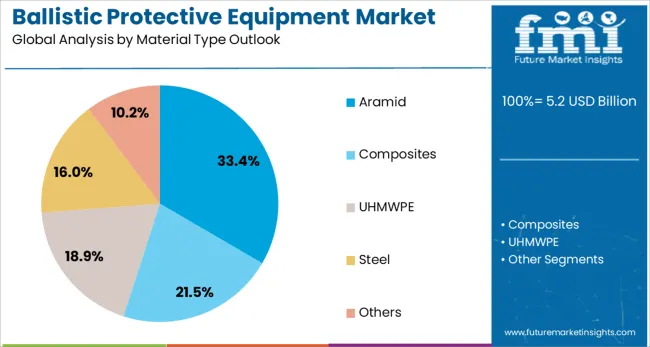
Aramid materials are expected to represent 33.4% of the material type segment in 2025. This significant share reflects the proven performance characteristics of aramid fibers in ballistic protection applications, providing excellent strength-to-weight ratios and consistent ballistic resistance. Modern aramid formulations deliver superior protection performance while maintaining lightweight characteristics essential for operational mobility. The segment benefits from established manufacturing processes and comprehensive material certification across defense and law enforcement markets.
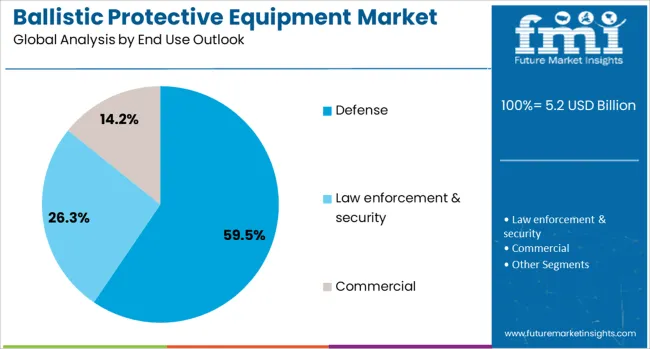
Defense applications are projected to contribute 59.5% of the end use segment in 2025. This dominant share reflects the critical importance of ballistic protection in military operations where personnel safety and mission effectiveness depend on reliable protective equipment. Defense ballistic protective equipment must meet stringent performance specifications while providing comprehensive protection against diverse threat environments. The segment is supported by continuous military modernization programs and increasing emphasis on force protection capabilities.
The ballistic protective equipment market is advancing steadily due to increasing security threats and growing recognition of personnel protection importance. However, the market faces challenges including high material costs, weight limitations for extended wear, and varying protection standards across different regions. Standardization efforts and certification programs continue to influence product development and market adoption patterns.
The growing deployment of next-generation composite materials and advanced fiber technologies is enabling superior ballistic protection with reduced weight and improved comfort characteristics. Multi-layer protection systems combining different materials provide comprehensive threat coverage while maintaining operational mobility. These advanced materials are particularly valuable for extended wear applications where comfort and flexibility are essential for operational effectiveness.
Modern ballistic protective equipment manufacturers are incorporating sensor systems and monitoring technologies that provide real-time protection status and impact detection capabilities. Integration of communication systems and health monitoring enables comprehensive situational awareness and personnel tracking during operations. Advanced technologies also support predictive maintenance and protection system optimization across diverse operational environments.
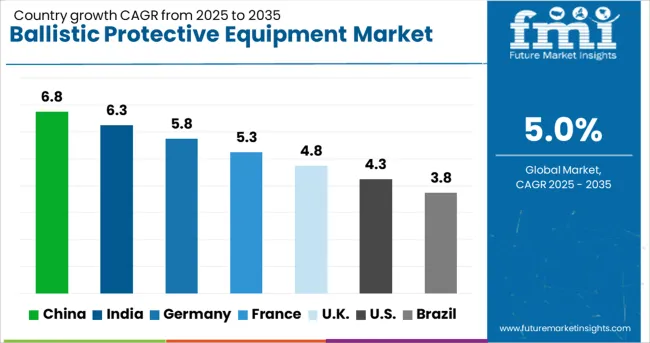
| Country | CAGR (2025-2035) |
| China | 6.8% |
| India | 6.3% |
| Germany | 5.8% |
| France | 5.3% |
| United Kingdom | 4.8% |
| United States | 4.3% |
| Brazil | 3.8% |
The ballistic protective equipment market demonstrates growth across major economies, with China leading at a 6.8% CAGR through 2035, driven by military modernization and expanding security requirements. India follows at 6.3%, supported by border security needs and defense capability development. Germany records 5.8% growth, emphasizing technological advancement and export market development. France shows 5.3% expansion, driven by defense programs and law enforcement modernization. The United Kingdom demonstrates 4.8% growth, focusing on advanced protection technologies. The United States records 4.3% growth, supported by established defense infrastructure, while Brazil grows at 3.8% with developing security applications.
The report covers an in-depth analysis of 40+ countries; seven top-performing countries are highlighted below.
Revenue from ballistic protective equipment in China is projected to exhibit the highest growth rate with a CAGR of 6.8% through 2035, driven by comprehensive military modernization programs and expanding domestic security requirements. The country's growing defense expenditure and increasing emphasis on force protection are creating significant demand for advanced ballistic protective solutions. Major defense manufacturers are establishing comprehensive production capabilities to support the growing requirements of military and paramilitary forces.
Government defense modernization initiatives are mandating adoption of advanced protection technologies and quality standards, driving investment in ballistic protective equipment capabilities throughout major industrial regions. Military infrastructure development programs are supporting establishment of specialized manufacturing facilities and technical expertise that enhance production capabilities across defense supply networks.
Revenue from ballistic protective equipment in India is expanding at a CAGR of 6.3%, supported by increasing border security requirements and comprehensive defense capability development programs. The country's expanding military and paramilitary forces are driving demand for reliable ballistic protection solutions that meet diverse operational requirements. Defense manufacturers and suppliers are gradually establishing capabilities to serve the growing needs of armed forces and security organizations.
Defense procurement modernization and domestic manufacturing initiatives are creating opportunities for specialized ballistic protection suppliers that can support diverse operational applications. Professional manufacturing and quality certification programs are developing technical expertise among producers, enabling comprehensive protective equipment supply chains that meet international standards and specifications.
Demand for ballistic protective equipment in Germany is projected to grow at a CAGR of 5.8%, supported by the country's emphasis on advanced material technologies and established defense export markets. German manufacturers are implementing comprehensive ballistic protection systems that meet stringent quality standards and international specifications. The market is characterized by focus on technological innovation, advanced testing protocols, and compliance with comprehensive safety requirements.
Defense industry investments are prioritizing advanced protection technologies that demonstrate superior performance and reliability while meeting German engineering standards. Professional certification programs are ensuring comprehensive technical expertise among manufacturers, enabling specialized ballistic protective equipment that supports diverse defense applications and export requirements.
Demand for ballistic protective equipment in France is expanding at a CAGR of 5.3%, driven by comprehensive defense programs and law enforcement modernization initiatives. French security forces are incorporating advanced ballistic protection technologies that meet operational effectiveness standards and safety requirements. The market benefits from established defense manufacturing capabilities and comprehensive security training programs.
Defense modernization programs are facilitating adoption of advanced protection systems that provide superior ballistic resistance while maintaining operational mobility. Professional quality standards are ensuring comprehensive technical capabilities among suppliers, enabling specialized ballistic protective equipment that meets evolving security requirements and international specifications.
Demand for ballistic protective equipment in the United Kingdom is projected to grow at a CAGR of 4.8%, supported by emphasis on advanced protection technologies and comprehensive operational requirements. British security forces are implementing specialized ballistic protection systems that meet stringent performance standards and operational effectiveness requirements. The market is characterized by focus on technological advancement, rigorous testing protocols, and compliance with comprehensive safety standards.
Defense technology investments are enabling deployment of advanced ballistic protection systems that demonstrate superior performance while maintaining operational flexibility. Professional development programs are ensuring specialized technical expertise among suppliers, enabling comprehensive ballistic protective equipment capabilities supporting evolving security and defense requirements.
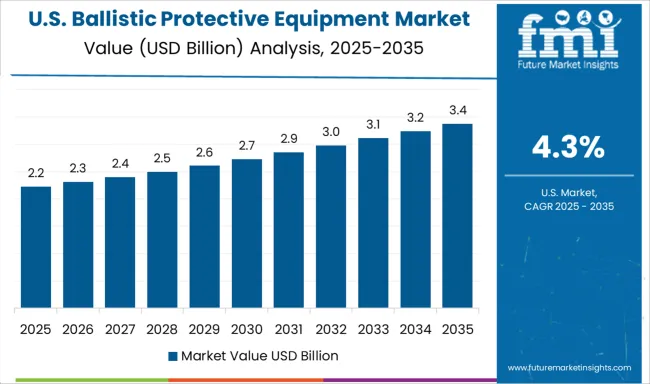
Demand for ballistic protective equipment in the United States is expanding at a CAGR of 4.3%, driven by established defense infrastructure and technology leadership in protection systems development. American manufacturers are maintaining comprehensive ballistic protection capabilities to serve diverse military, law enforcement, and civilian requirements. The market benefits from substantial research investment and comprehensive testing programs across various threat environments.
Defense technology investments are enabling continued advancement of ballistic protection systems that demonstrate practical operational benefits and enhanced safety performance. Professional development initiatives are maintaining technical expertise among industry participants, enabling comprehensive ballistic protective equipment capabilities supporting evolving security requirements.
Revenue from ballistic protective equipment in Brazil is growing at a CAGR of 3.8%, driven by developing security applications and increasing law enforcement requirements. The country's expanding security forces are exploring ballistic protection technologies that can address operational challenges and improve personnel safety. Defense and security suppliers are investing in capability development to serve evolving protection requirements.
Security development programs are facilitating evaluation of ballistic protection technologies that support comprehensive law enforcement applications across diverse operational environments. Professional capability development initiatives are enhancing technical expertise among industry participants, enabling specialized ballistic protective equipment that meets developing security and defense requirements.
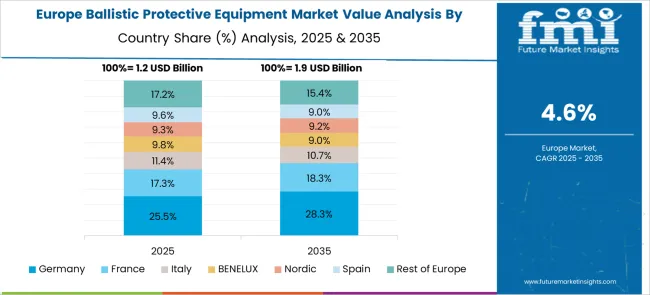
The ballistic protective equipment market in Europe is projected to grow steadily across major countries, with Germany leading the regional market development. The United Kingdom maintains strong demand for ballistic protective equipment, supported by established defense forces and comprehensive law enforcement requirements. France demonstrates consistent investment in advanced protection technologies, driven by defense modernization programs and security enhancement initiatives.
Germany is expected to maintain its leadership position in European ballistic protective equipment consumption, supported by its advanced defense manufacturing infrastructure and established export capabilities. The country benefits from comprehensive research and development programs and supportive regulatory environment for protection technology advancement.

The ballistic protective equipment market is defined by competition among defense contractors, protection system manufacturers, and advanced materials companies. Companies are investing in advanced material technologies, rigorous testing protocols, comprehensive certification programs, and technical expertise to deliver high-performance, reliable, and cost-effective ballistic protection solutions. Strategic partnerships, technological innovation, and regulatory compliance are central to strengthening product portfolios and market presence.
BAE Systems Plc, United Kingdom-based, offers comprehensive ballistic protection systems with focus on defense applications and advanced material technologies. Rheinmetall AG, Germany, provides integrated protection solutions with emphasis on vehicle and personnel protection systems. Honeywell International Inc., United States, delivers advanced fiber technologies and comprehensive material solutions for ballistic applications. Point Blank Enterprise Inc., United States, focuses on soft armor systems and law enforcement protection solutions.
Morgan Advanced Materials, United Kingdom, emphasizes advanced composite materials and specialized protection technologies. ArmorSource LLC, United States, provides comprehensive ballistic protection systems for law enforcement and military applications. Craig International Ballistics, Survitec Group Ltd, United Kingdom, Safe Life Defense, United States, Tactical Assault Gear (TAG), United States, Hellweg International Pty. Ltd, Australia, MKU Limited, India, Mehler Vario System, Germany, and Seyntex N.V., Belgium, offer specialized ballistic protection expertise, advanced manufacturing capabilities, and reliable supply systems across global defense and security markets.
| Items | Values |
|---|---|
| Quantitative Units | USD 8.4 billion |
| Application | Soft armor, hard armor, head protection |
| Material Type | Aramid, composites, UHMWPE, steel, and others |
| End Use | Defense, law enforcement & security, commercial |
| Regions Covered | North America, Europe, East Asia, South Asia & Pacific, Latin America, Middle East & Africa |
| Country Covered | United States, Canada, United Kingdom, Germany, France, China, Japan, South Korea, India, Brazil, Australia and 40+ countries |
| Key Companies Profiled | BAE Systems Plc, Rheinmetall AG, Honeywell International Inc., Point Blank Enterprise Inc., Morgan Advanced Materials, ArmorSource LLC, Craig International Ballistics, Survitec Group Ltd, Safe Life Defense, Tactical Assault Gear (TAG), Hellweg International Pty. Ltd, MKU Limited, Mehler Vario System, Seyntex N.V. |
| Additional Attributes | Dollar sales by application, material type, and end use, regional demand trends across North America, Europe, and Asia-Pacific, competitive landscape with established defense contractors and specialized manufacturers, production capabilities for different protection levels and applications, integration with advanced material technologies and testing protocols, innovations in lightweight protection systems and comfort enhancement technologies, and adoption of smart protection solutions with integrated monitoring and communication systems for comprehensive personnel safety optimization. |
North America
The global ballistic protective equipment market is estimated to be valued at USD 5.2 billion in 2025.
The market size for the ballistic protective equipment market is projected to reach USD 8.4 billion by 2035.
The ballistic protective equipment market is expected to grow at a 5.0% CAGR between 2025 and 2035.
The key product types in ballistic protective equipment market are soft armor, hard armor and head protection.
In terms of material type outlook, aramid segment to command 33.4% share in the ballistic protective equipment market in 2025.






Our Research Products

The "Full Research Suite" delivers actionable market intel, deep dives on markets or technologies, so clients act faster, cut risk, and unlock growth.

The Leaderboard benchmarks and ranks top vendors, classifying them as Established Leaders, Leading Challengers, or Disruptors & Challengers.

Locates where complements amplify value and substitutes erode it, forecasting net impact by horizon

We deliver granular, decision-grade intel: market sizing, 5-year forecasts, pricing, adoption, usage, revenue, and operational KPIs—plus competitor tracking, regulation, and value chains—across 60 countries broadly.

Spot the shifts before they hit your P&L. We track inflection points, adoption curves, pricing moves, and ecosystem plays to show where demand is heading, why it is changing, and what to do next across high-growth markets and disruptive tech

Real-time reads of user behavior. We track shifting priorities, perceptions of today’s and next-gen services, and provider experience, then pace how fast tech moves from trial to adoption, blending buyer, consumer, and channel inputs with social signals (#WhySwitch, #UX).

Partner with our analyst team to build a custom report designed around your business priorities. From analysing market trends to assessing competitors or crafting bespoke datasets, we tailor insights to your needs.
Supplier Intelligence
Discovery & Profiling
Capacity & Footprint
Performance & Risk
Compliance & Governance
Commercial Readiness
Who Supplies Whom
Scorecards & Shortlists
Playbooks & Docs
Category Intelligence
Definition & Scope
Demand & Use Cases
Cost Drivers
Market Structure
Supply Chain Map
Trade & Policy
Operating Norms
Deliverables
Buyer Intelligence
Account Basics
Spend & Scope
Procurement Model
Vendor Requirements
Terms & Policies
Entry Strategy
Pain Points & Triggers
Outputs
Pricing Analysis
Benchmarks
Trends
Should-Cost
Indexation
Landed Cost
Commercial Terms
Deliverables
Brand Analysis
Positioning & Value Prop
Share & Presence
Customer Evidence
Go-to-Market
Digital & Reputation
Compliance & Trust
KPIs & Gaps
Outputs
Full Research Suite comprises of:
Market outlook & trends analysis
Interviews & case studies
Strategic recommendations
Vendor profiles & capabilities analysis
5-year forecasts
8 regions and 60+ country-level data splits
Market segment data splits
12 months of continuous data updates
DELIVERED AS:
PDF EXCEL ONLINE
Ballistic Protection Material Market Size and Share Forecast Outlook 2025 to 2035
Ballistic Floatation Vest Market Size and Share Forecast Outlook 2025 to 2035
Ballistic Protection Market Size and Share Forecast Outlook 2025 to 2035
Ballistic Composites Market Size and Share Forecast Outlook 2025 to 2035
Ballistic Protection Scanners Market
Protective Glove Market Forecast Outlook 2025 to 2035
Protective Film Market Size and Share Forecast Outlook 2025 to 2035
Protective Earth Resistance Meter Market Size and Share Forecast Outlook 2025 to 2035
Protective Building Materials Market Size and Share Forecast Outlook 2025 to 2035
Protective Wrapping Paper Market Size and Share Forecast Outlook 2025 to 2035
Protective Mask Market Size and Share Forecast Outlook 2025 to 2035
Protective Packaging Market Analysis - Size, Share, and Forecast Outlook 2025 to 2035
Protective Packaging Industry Analysis in United States and Canada - Size, Share, and Forecast 2025 to 2035
Protective Clothing Market - Trends, Growth & Forecast 2025 to 2035
Protective Eyewear Market Trends – Industry Growth & Forecast 2025 to 2035
Market Share Distribution Among Protective Packaging Manufacturers
Market Share Insights of Leading Protective Textiles Providers
Protective Relay Market
Protective Footwear Market
Protective Films Tapes Market

Thank you!
You will receive an email from our Business Development Manager. Please be sure to check your SPAM/JUNK folder too.
Chat With
MaRIA